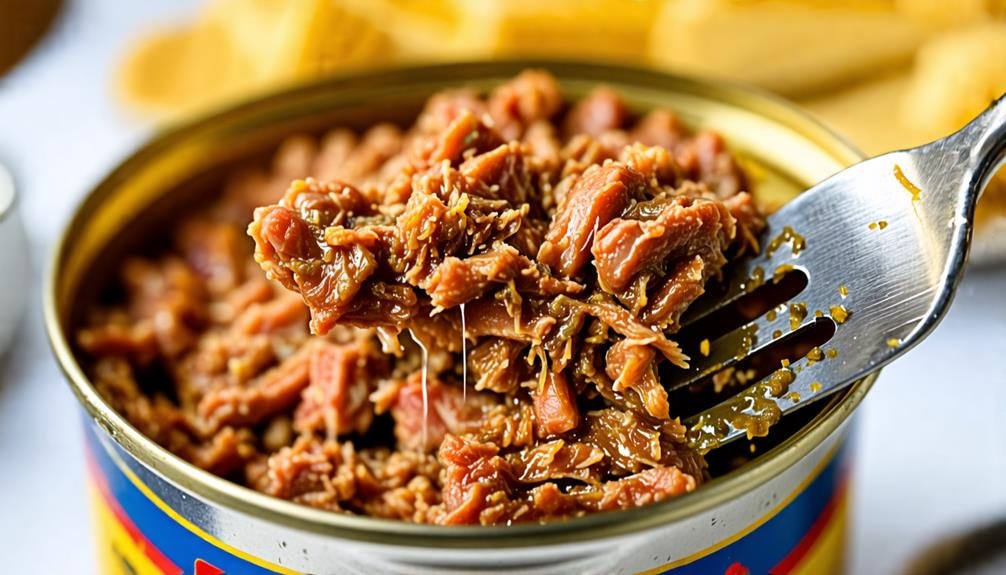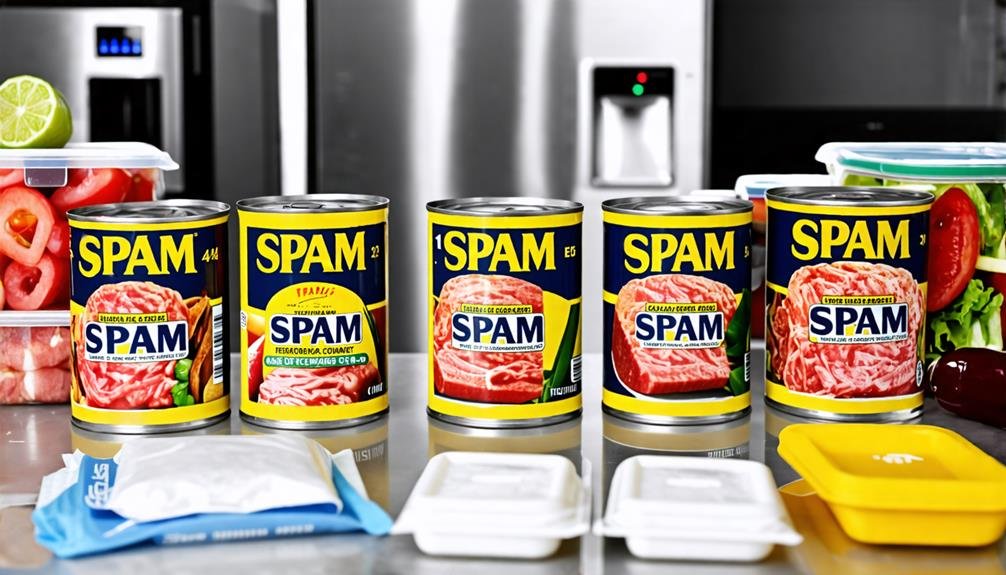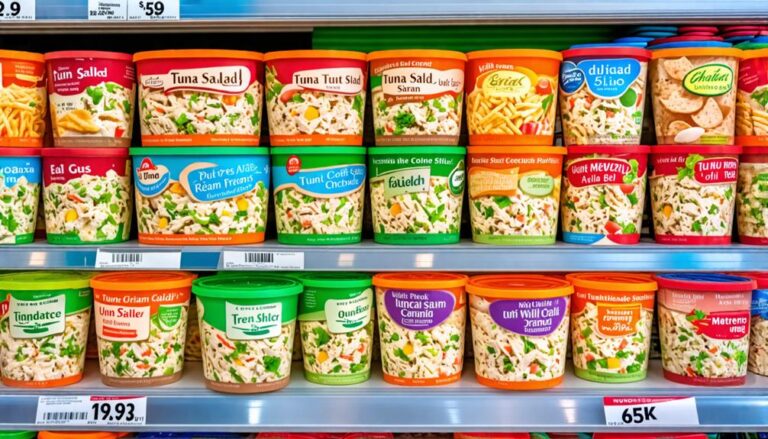After you open a can of SPAM, it can last about 7 to 10 days if stored properly in an airtight container. This impressive shelf life makes SPAM a reliable kitchen staple. To optimize freshness, always refrigerate promptly and label your containers. Keep an eye out for signs of spoilage such as a slimy texture, discoloration, or mold. SPAM's unique ingredients and meticulous preservation process, including sodium nitrite, contribute to its longevity. Understanding how to store it can greatly extend its usability, ensuring it remains a versatile option for your meals. Explore more tips on keeping your SPAM delightful!
Understanding SPAM's Longevity
Exploring the reasons behind SPAM's enduring appeal highlights the efficiency of its preservatives and optimal storage techniques. The remarkable shelf life of SPAM, a product from Hormel Foods, is largely attributed to its distinctive ingredient blend that enhances taste while preventing decay. When stored appropriately, a sealed can of SPAM can remain safe for consumption for as long as five years, making it a preferred choice for individuals who prioritize self-sufficiency and the convenience of emergency food supplies.
Once a can of SPAM is opened, proper food storage becomes essential to maintain quality. The United States Department of Agriculture suggests consuming SPAM within four days of opening. However, if placed in an airtight container, it can last between seven to ten days in a refrigerator. This adaptability encourages inventive meal preparation and ensures that SPAM continues to be a reliable protein source in your kitchen.
Why SPAM Lasts Long
The remarkable longevity of SPAM can be attributed to its carefully chosen ingredients and innovative preservation methods. Central to its shelf stability is sodium nitrite, which not only improves safety by preventing botulism but also helps sustain the product's quality over time. Coupled with a meticulous preservative process, these elements work together to guarantee that unopened cans can last up to five years, making SPAM a dependable staple in many kitchens.
Key Ingredients Explained
One of the main reasons SPAM maintains an extended shelf life is its unique blend of ingredients. Sodium nitrite, a key preservative, effectively inhibits the growth of harmful bacteria and prevents botulism. This thoughtful formulation ensures that your can of SPAM remains safe and flavorful for years, making it a cherished staple for many households.
- Pork and Water: These primary components create a robust foundation that enhances flavor and texture.
- Potato Starch: This natural thickener contributes to the consistency, giving SPAM its signature mouthfeel.
- Sugar and Salt: These elements not only elevate taste but also serve vital roles in preserving the meat.
Together, these components undergo a rigorous preservation process, allowing unopened cans to last up to five years. Whether you're an outdoor enthusiast or simply appreciate convenience, SPAM's longevity provides flexibility in meal planning and preparation. So, you can trust that your SPAM can be a dependable partner in your culinary adventures!
Role of Sodium Nitrite
Sodium nitrite serves a vital function in the preservation of SPAM, a popular canned meat product. It effectively prevents the growth of harmful bacteria, including Clostridium botulinum, which causes botulism. This action significantly extends the shelf life of SPAM, allowing it to remain safe for consumption for up to five years when stored in unopened cans.
The effectiveness of sodium nitrite lies in its ability to neutralize potential toxins while maintaining the quality of SPAM. This preservative not only enhances safety but also helps retain the savory flavor and appealing texture that SPAM enthusiasts cherish. The role of sodium nitrite exemplifies the intersection of food science and culinary enjoyment, enabling consumers to savor this convenient protein source without worries.
In addition, the use of sodium nitrite aligns with a growing consumer preference for long-lasting food options. As modern lifestyles become increasingly hectic, the knowledge that SPAM remains a reliable staple in kitchens offers peace of mind. With sodium nitrite, SPAM represents a blend of innovation and tradition in food preservation.
Preservative Process Benefits
The preservation of SPAM relies on a strategic combination of ingredients and techniques that enhance its safety and longevity for consumers. This distinctive formulation not only ensures that SPAM remains flavorful but also offers reassurance regarding its edibility. Here are some significant advantages of the preservation method:
- Sodium Nitrite: This ingredient inhibits the development of harmful microorganisms and toxins.
- Extended Shelf Life: Unopened SPAM cans have a shelf life of up to five years, establishing SPAM as a dependable pantry essential.
- Flavor and Texture Retention: Preservatives assist in maintaining the taste and consistency of SPAM over extended periods.
The careful preservation process elevates SPAM into a versatile food choice that encourages creativity in the kitchen. Whether for outdoor camping, meal prepping, or simply seeking a quick snack, SPAM's durability allows for enjoyment at your convenience. With its delightful flavor and dependable safety, SPAM remains a favorite for individuals looking for both nutrition and flexibility in their culinary pursuits. Embrace the opportunity to create, experiment, and enjoy every delicious bite!
Signs of Spoiled SPAM

Recognizing the signs of spoiled SPAM is essential for ensuring food safety and enjoyment. Texture changes, such as a slimy or spongy feel, can indicate spoilage, while unusual odors and off colors serve as clear warning signs. By being vigilant about these visual and sensory cues, you can confidently determine when it's time to discard your SPAM and avoid any unpleasant surprises.
Texture Changes Indicate Spoilage
A noticeable change in texture, such as a slimy or spongy feel, clearly indicates that SPAM has spoiled and should be discarded. Understanding these signs is essential for maintaining food safety and ensuring your culinary experiences remain enjoyable. When handling SPAM, be vigilant for the following texture-related clues:
- Slimy Surface: A slippery coating on the meat can signal bacterial growth.
- Spongy Consistency: If the meat feels unusually soft, it's best to err on the side of caution.
- Dents or Puffs: Alterations in the can's shape can affect the contents, potentially leading to spoilage.
Food should empower you, not restrict your enjoyment. Recognizing these texture changes ensures your health and allows you to savor SPAM at its best. The freedom to enjoy your meal without worry is truly liberating! So, if you notice any of these signs, remember that your safety is paramount—discard the SPAM and embrace the delight of fresh, delicious meals.
Odors to Watch For
A foul or sour odor from SPAM is a clear sign that the product has gone bad and should not be eaten. This smell can vary from a slightly unpleasant aroma to a strong, nauseating stench, serving as an important health warning. Your sense of smell is a valuable tool in assessing food freshness, and odors are key indicators.
If you notice any odd smells, it's important to take action quickly. Spoiled SPAM not only loses its enjoyable flavor but can also pose serious health risks. Just because the appearance seems fine doesn't guarantee safety—trust your sense of smell!
An off odor might also come with other spoilage signs like changes in texture or color, but let's concentrate on those warning scents for now. To safely enjoy SPAM, ensure you store it correctly and consume it within the suggested timeframe after opening. By being vigilant and responsive to these smells, you can enjoy your meals with assurance. So, take a moment to breathe deeply and keep your culinary experiences safe!
Visual Cues of Spoilage
Visual signs of spoilage can indicate that SPAM® is no longer safe to eat. Apart from unpleasant smells, certain textures and colors can serve as warning signals. To ensure your meals remain enjoyable and safe, look out for these visual indicators:
- A slimy or spongy texture that feels unusual when touched.
- Discoloration, such as gray or greenish shades, straying from SPAM's typical pink hue.
- Signs of mold or odd spots on the surface.
Identifying these visual cues is essential for your health and safety. Trust your instincts—if the appearance or feel of the SPAM® seems off, it's wise to discard it. While SPAM® is known for its long shelf life, be sure to monitor its condition after opening. Your enjoyment of food should never compromise your well-being. Stay alert and appreciate the taste of freshness!
Recommended Shelf Life After Opening
The recommended shelf life of SPAM, a popular canned meat product by Hormel Foods, after opening is generally within 4 days. However, with proper refrigeration, it can last up to 7-10 days. This timeline allows you to enjoy this versatile protein while ensuring both safety and flavor. Following USDA guidelines, it's advisable to consume SPAM within 4 days to minimize the risk of spoilage. With careful storage practices, you can extend its life slightly, opening up more opportunities for culinary experimentation.
SPAM's distinct flavor and texture make it a delightful addition to a variety of meals. Whether you're preparing a quick breakfast or crafting a creative lunch, understanding its shelf life helps you maximize your ingredients. While time may be limited, the delicious possibilities with SPAM are endless!
Proper Storage Techniques

To ensure the freshness and safety of opened SPAM, it is vital to adopt effective storage methods that reduce exposure to air and harmful bacteria. By implementing these strategies, you can maintain the quality and safety of your SPAM for an extended period.
- Utilize airtight containers: Transfer your opened SPAM into a high-quality, airtight container to preserve its flavor.
- Refrigerate promptly: Store your SPAM in the refrigerator to inhibit spoilage and extend its shelf life.
- Label and date your containers: Clearly mark your container with the opening date to monitor its freshness effectively.
The Science Behind SPAM
Understanding the science behind SPAM reveals how its unique formulation and preservation methods contribute to its extended shelf life and safety. At the core of SPAM's longevity is sodium nitrite, a potent preservative that enriches flavor and prevents the growth of harmful bacteria, including Clostridium botulinum, the bacteria responsible for botulism. This crucial ingredient acts as a guardian, ensuring that your can of SPAM remains safe to consume long after its production.
The careful balance of ingredients—pork, water, potato starch, sugar, salt, and sodium nitrite—creates an environment where spoilage is significantly delayed. This meticulous preservation process allows unopened cans of SPAM to last for up to five years, a marvel in food science that speaks to the ingenuity of modern food technology.
Moreover, SPAM's best-by date often suggests a three-year mark, but it can still be perfectly edible well beyond that time frame. This fascinating interplay of chemistry and culinary craftsmanship empowers consumers with food freedom and invites them to explore a world where convenience meets safety. So, the next time you open a can of SPAM, remember the science that stands behind it, ensuring your culinary adventures can continue unabated!
Creative Ways to Use SPAM

Often overlooked, SPAM can be creatively incorporated into a variety of dishes that enrich its flavor and texture, transforming it into a versatile ingredient in modern cuisine. This unique product is not just a nostalgic relic of the past; it offers a canvas for culinary exploration. Here are some imaginative ways to welcome SPAM:
- SPAM Fried Rice: Stir-fry SPAM with vibrant vegetables and fluffy rice for a savory, satisfying meal.
- SPAM Tacos: Crisp up SPAM cubes and serve them in soft tortillas with fresh toppings like avocado and salsa for a delightful twist.
- SPAM Sushi: Combine cooked SPAM with seasoned sushi rice and nori for a flavorful fusion delight.
These recipes not only highlight SPAM's versatility but also invite you to experiment freely in the kitchen. Whether you're looking for a quick meal or a creative dish to impress friends, SPAM proves that it can shine in unexpected ways. Welcome the freedom to innovate and let your culinary imagination run wild with this unconventional ingredient!
Tips for Extending Freshness
To extend the freshness of SPAM, proper storage and handling techniques are essential for maximizing its shelf life after opening. Begin by placing any unused SPAM into an airtight container. This action minimizes exposure to air, which can accelerate spoilage. For convenience, consider slicing the SPAM into smaller portions before sealing them in bags, allowing you to thaw just the right amount for your next meal.
Freezing SPAM is an excellent method to enhance its longevity. When slicing, be sure to eliminate excess air from the bags to avoid freezer burn. This practice helps maintain flavor and ensures a pleasant texture upon defrosting.
Temperature control is crucial! Store your opened SPAM in the refrigerator, ideally keeping it at a steady temperature below 40°F. While the USDA suggests consuming it within four days, optimal storage can extend its freshness up to ten days.




